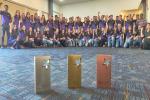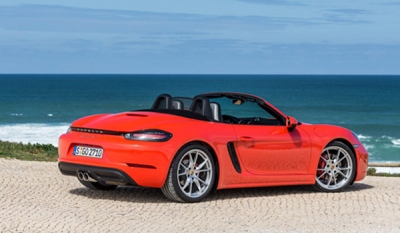The two-seat convertibles are now more powerful yet more fuel efficient.
The centerpiece of the new model series is the newly devel-oped four-cylinder flat engine with turbocharging.
The 718 Boxster develops 220 kW (300 hp) of power from two litres of engine displacement, while the 718 Boxster S produces 257 kW (350 hp) from 2.5 litres of displacement.
In the S-model, Porsche also uses a turbocharger with variable turbine geometry.
In fact Porsche is now the only manufacturer to offer VTG technology in production cars with petrol-driven engines, both in the 911 Turbo and in the 718 Boxster S.
Impressive here are the considerable power gain of 26 kW (35 hp) compared to the previous Boxster models and the efficiency of the new turbo engines.
The new 718 Boxster models also have fuel economy improvements of up to 13 per cent.
While the completely new chassis tuning and stronger brakes provide for passionate and sporty driving pleasure, inside a newly designed dash panel frames the cockpit.
In addition, the latest generation of Porsche Communication Management (PCM), Porsche’s control cen-ter for audio, communication and navigation functions on a state-of-the-art touchscreen comes as standard.
The 718 model line can be recognized at first glance; the front end of the new roadster ex-hibits a much more sculptural form with a wider and more masculine appearance.
The much larger cooling air intakes at the front provide a distinct exterior expression of the new turbo engine concept while the new design of the bi-xenon headlights debuts with integrated LED daytime running lights.
LED headlights with four-point daytime running lights are also availa-ble as a new option.
More information about the 718 Boxster models
Efficient turbo power from four cylinders
The launch of the new 718 Boxster generation represents the first time since the late 1960's that Porsche is again implementing sports cars with four-cylinder flat engines.
Turbocharging significantly boosts torque.
The two-litre engine of the 718 Boxster has a maximum torque of 380 Newton metres 100 Newton metres more, which is available from 1,950 rpm to 4,500 rpm.
The 2.5-litre engine of the 718 Boxster S even attains 420 Newton metres (60 Newton metres more) over a speed range from 1,900 rpm to 4,500 rpm.
Thus, the new 718 Boxster models sprint even faster. The 718 Boxster – with PDK and the Sport Chrono Package – sprints from zero to 100 km/h in 4.7 seconds (0.8 seconds faster).
The 718 Boxster S with the same equipment completes this discipline in 4.2 seconds (0.6 sec-onds faster).
The top speed of the 718 Boxster is 275 km/h, and the 718 Boxster S has a top speed of 285 km/h.
The Porsche turbo concept is boosting driving performance while improving fuel economy.
In the 718 Boxster, the four-cylinder flat engine with PDK has a NEDC fuel consumption figure of 6.9 l/100 km (1.0 l/100 km less).
In the 718 Boxster S, the 2.5 litre turbo flat engine with PDK consumes just 7.3 l/100 km (0.9 l/100 km less).
The 718 models come with a six-speed manual transmission as standard.
The Porsche Dop-pelkupplungsgetriebe (PDK), which now features fuel-saving virtual gears, is available as an option.
New design emphasises sharpened profile
From a side view, identifying features of the new model line include new, independently styled wings and side sills.
Larger air inlet panels with two fins emphasise the car's dynamic look.
The doors are now designed without door handle recess covers.
New 19-inch wheels are standard on the 718 Boxster S. 20-inch diameter wheels are available as an option.
The redesigned rear body of the 718 Boxster has a much wider look – especially due to the accent strip with integrated Porsche badge between the tail lights.
The entirely redeveloped tail lights are distinguished by their three-dimensional LED technology and four-point brake lights.
Sportier tuning of chassis for greater agility
In its driving dynamics, the new roadster follows in the tracks of the original 718.
The car's completely re-tuned chassis enhances cornering performance.
The electromechanical steer-ing system is configured to be ten per cent more direct.
This makes the 718 Boxster even more agile and easier to steer, both on circuit tracks and in everyday traffic.
Minus ten and minus 20: Porsche Active Suspension Management
Available at extra charge for the roadsters is Porsche Active Suspension Management (PASM) with a ten millimeter lower ride height.
For the first time, the PASM sport chassis with a 20 millimeter lower ride height is available as an option for the 718 Boxster S.
The active chassis, which has also been re-tuned, offers an even broader spread between long-distance touring comfort and dynamic sporty stiffness.
Extensive Sport Chrono Package for dynamic driving experience
As in the 911, the optional Sport Chrono Package now comprises the Individual programme in addition to the three settings Normal, Sport and Sport Plus.
In sports cars with PDK, the Sport Response Button has been added, which is located at the middle of the driving pro-gramme switch.
Inspired by car racing, it enables the driver to configure the responsiveness of the engine and the PDK to be very direct.
Interior has new Porsche Communication Management as standard
Awaiting the driver in the cockpit of the 718 Boxster is the familiar Porsche interior environ-ment, now upgraded with new elements such as the instrument panel.
Another central ele-ment of the new interior layout is the Porsche Communication Management (PCM) unit with mobile phone preparation, audio interfaces and the Sound Package Plus with 110 watts of audio power.



























